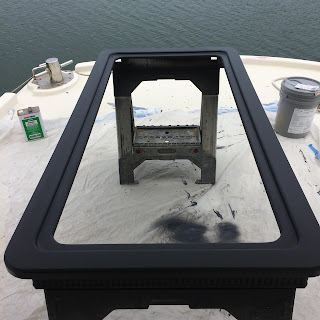Fairing, is measuring and a little math.
There is a learning curve with using Awlgrips Awlfair to fair, and deciding when it it is time to prime. The trouble with priming, is that most people close the door behind them and have trouble going back a stage to fairing after the first prime if things were not quite far enough along.
If you prime over a raised lip edge like the above picture, but were happy enough with the shape to have primed it... It takes a bit of gumption to pick up the sander and long board and block it back flat instead of just pulling a little filler across the lip and making a hump. Most folks can't see that in a finished paint job, but a wavy shadow line when the sun comes across the hull will show it.
My two cents, is to always jump up to the grit you will be sanding the primer with, before you prime and look for areas where you still have 40 or 80 grit marks. Test the surface to see if you will be making contact, prior to priming. I use a 3M 16 inch long board, with 3M gold roll paper adhesive backed paper to do this with a DA of the same grit in the other hand.
If you have been sanding in 80 grit, or 120 grit on a DA, and are thinking you want to prime with a high build primer, a 16 inch board will show you where the wiggles and low spots will be and the burn through that first layer of primer.
The math, aspect involves finding a way to gauge the depth of the low spots around the minor high spots that are in a surface. I like to use a 2 foot by 2 foot square as the working surface, as you can easily smooth out an area that large through progressively finer grits, quickly.
I like 3M Dry Guide Coat, to show the sanding scratches, and apply a fresh coat after going over the areas in question... One of the things that works rather well, is to do a 2x2 square foot area, twice with guide coat and prove that the scratch profile has been changed. It doesn't take a lot of sanding to wipe away the guide coat, but sometimes it takes an extra minute or two to get things smoothed out to the next finer grit. Dusting things down with guide coat twice, proves you did it. Sometimes that can save your bacon when it comes to putting on a layer of primer, and on convex or concave surfaces it saves some elbow work with a long board getting things smooth enough to see what you've got.
If we know that we have 80 grit sanding scratches present all over the surface, we can go to a larger sander with 120 grit sandpaper, and remove the 80 grit scratches that come off easily on the first guide coated sanding.
80 grit scratches have a depth of .022, while 120 grit scratches have a depth of .012.
For reference, 180 grit are .004 and 220 grit are .002.
The goal of finishing, is to get down fine enough that primer will fill the scratches that are present without shrinking and printing the scratches at a later date. That obligates you to remove the 80 grit scratches, and the 120 grit scratches.
The Measuring aspect, means that if your 16 inch board passes over an area that still has 80 grit scratches with 120 grit, that your high spots are at least .012 deep.
What this means when you go to prime the surface, is that for a dry mil thickness (A mil is equal to .001) a product that builds 2-3 dry mils per full wet coat, is going to take a lot of passes and a lot of coats to build up enough material not to remain a low spot. Removing the material, around the low spot to the extent that the long board still fits the surface, saves a lot of material and time when priming.
The beautiful thing about primer, is that it builds up a surface evenly. The only bad thing about that is if you build up an imperfect surface, the same low spots and high spots are present until you sand off all the material on the high spots. That is a lot more work, than sanding out the base material smooth enough that the first few shots of primer are in the ball park without burning through.
That is the math behind burning through primer back into your fairing material... The learning curve, is to figure out a way to gauge when you can Prime and do so successfully, without burning through. Fairing over an imperfect hull, and bumping back into gelcoat or laminate is where you have to know when to stop your sanding and start adding material.
Putting this all together, is to know your paint systems build potential. Get the base surface to a smooth enough finish, that you can "Prime your way out" to a finished paint job.










